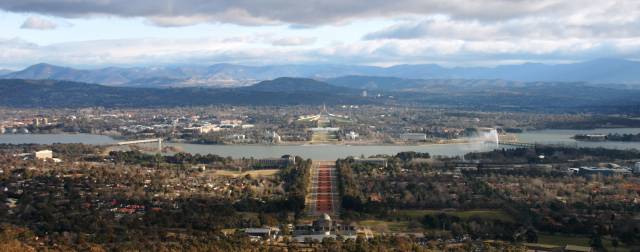
Happy Birthday Canberra

When the Minister for Home Affairs, King O’Malley wrote his introduction to the milestone volume Canberra – Capital City of the Commonwealth of Australia he declared for posterity that ‘Such an opportunity as this, the Commonwealth selecting a site for its national city in almost virgin country, comes to few nations and comes but once in a history.’
Canberra’s foundation stones were laid and naming ceremonies were performed on 12 March 1913 and the capital has had a number of events to help celebrate its 100 years of existence.
The city did not begin as a compromise between feuding Sydney and Melbourne and unlike many major world cities, it was not created because of war, revolution, disease, natural disaster or to establish a convict settlement as was the case in different States.
Instead, it was a nation lucky enough to be looking for a capital city and the new Commonwealth of Australia wanted their future capital to be the treasure house of a nation’s heart.
Prime Minister Andrew Fisher said he anticipated a city where the best thoughts of Australia would be expressed, a seat of learning as well as of politics and the home of art.
 Now spread to over 100 suburbs, Canberra has grown to more than the scheme envisaged by American Walter Burley Griffin and his wife Marion, who were the chief and original architects of the city. In 1914, the couple moved from Chicago and made Australia their home for the next 20 years.
Now spread to over 100 suburbs, Canberra has grown to more than the scheme envisaged by American Walter Burley Griffin and his wife Marion, who were the chief and original architects of the city. In 1914, the couple moved from Chicago and made Australia their home for the next 20 years.
When the call was made for designs for the city, the winning entry was No 29, submitted by the Griffins and material drawn from the couple’s practices in the US, India and Australia are showcased on display.
Wednesday 12 March 1913 was Canberra’s first day of genuine national significance when Lady Denman, wife of then Governor General Lord Denman, stood at the newly laid foundation stones and announced the name of Australia’s capital city as Canberra.
From this beginning have emerged the national political centre, the national museum, library, arts gallery, arboretum, war memorial and many other attractions which bring thousands of visitors from interstate and overseas.
The original Parliament House became too small to accommodate the politicians and public servants required to service the needs of the nation. A new Parliament House was created and opened by Queen Elizabeth on 9 May 1988 and is designed to have a lifespan of more than 200 years. Not even Canberra residents are aware that a great method to see the capital is from the roof of Parliament House where you can get an uninterrupted view across Lake Burley Griffin and up Anzac Parade to the War Memorial.
Visitors are especially made aware of Australia’s copy of the Magna Carta which is one of only two held outside the United Kingdom. In 1297, the ‘Magna Carta’ established the rights of the English people and restricted the powers of the King.
Other treasures to see are the Great Hall Tapestry, based on a painting by Arthur Boyd, and Queen Victoria’s writing table which she gave to the Australian Parliament when she gave her consent to the Commonwealth of Australia Constitution Bill in 1900.
There are many theories on how the city’s name was decided. The most popular is that it came from an old aboriginal word meaning ‘meeting place’ which is a good description for the existence of Canberra, the national capital of Australia.
Article extracted from Freemason magazine, June 2013, pages 12 and 13.


